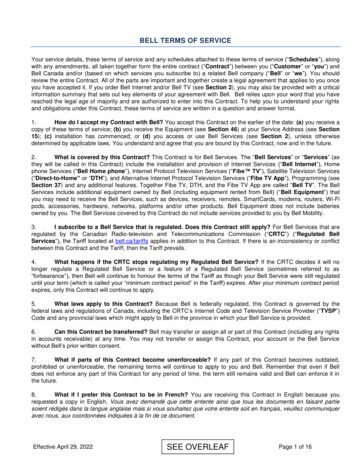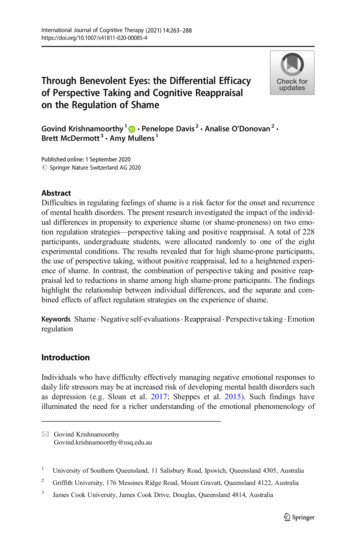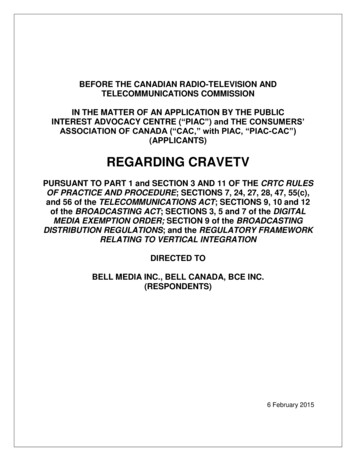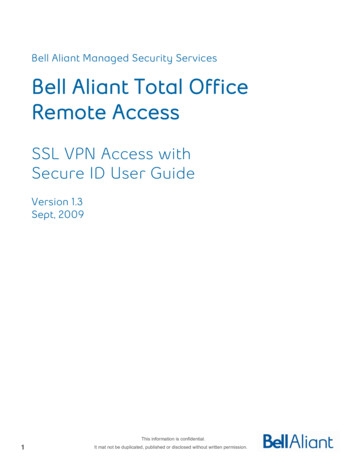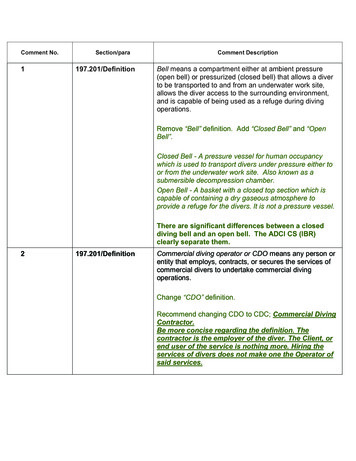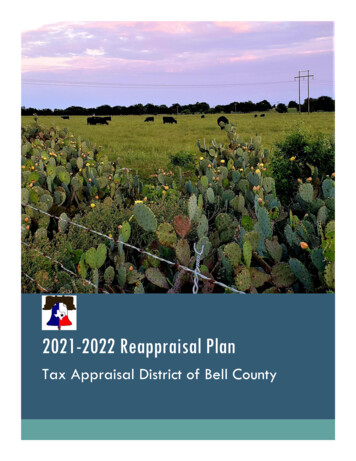
Transcription
2021-2022 Reappraisal PlanTax Appraisal District of Bell County
Adopted By the Tax Appraisal District of Bell CountyBoard of DirectorsSeptember 8, 2020Royce Matkin – ChairmanJared Bryan – Vice Chairman / SecretarySusan JonesSkip CaruthBarry HarperKevin KochHoward AreyChief Appraiser –Billy White, AAS, CAE, CCA, RPA1 Page
CONTENTSExecutive Summary. 3Texas Property Tax Code Requirement. 5Reappraisal Cycle . 6Appraisal Activities . 8Residential Valuation Process . 11Commercial and Light Industrial Valuation Process . 16Business Personal Property Valuation Process . 24Utility, Railroad, Pipeline, Industrial and Industrial Personal Property Valuation Process. 27CAD Plan for Periodic Reappraisal of Industrial Real Property. 28CAD Plan for Periodic Reappraisal of Industrial Personal Property . 29Limiting Conditions . 30Addendums . 31Addendum A . 32Addendum B . 39Addendum C . 422 Page
EXECUTIVE SUMMARYThe Tax Appraisal District of Bell County (TADBC) has prepared and published this reappraisal plan to provide our Board of Directors, taxingentities and property owners with a better understanding of the district's responsibilities and activities. Additionally, it is intended to complywith requirements of Tax Code Sec. 6.05(i) and 25.18.TADBC is a political subdivision of the State of Texas created effective January 1, 1980. The provisions of the Texas Property Tax Code governthe legal, statutory, and administrative requirements of the appraisal district. A seven-member Board of Directors, appointed by the taxingunits within the boundaries of Bell County, constitutes the district’s governing body. Killeen ISD, City of Killeen, Temple ISD, City of Temple, andBell County appoint one director each. Belton ISD and City of Belton together appoint one director and all other entities appoint the last directorby vote based on levy percentages. The chief appraiser, appointed by the Board of Directors, is the chief administrator and chief executiveofficer of the appraisal district.TADBC is responsible for local property tax appraisal and exemption administration for all or part of thirty-nine jurisdictions or taxing units inthe county. These taxing entities are listed below:TAXING ENTITIESBELL COUNTYROAD DISTRICTACADEMY ISDBARTLETT ISDBELTON ISDBRUCEVILLE-EDDY ISDCOPPERAS COVE ISDFLORENCE ISDGATESVILLE ISDHOLLAND ISDKILLEEN ISDLAMPASAS ISDMOODY ISDROGERS ISDROSEBUD-LOTT ISDSALADO ISDTEMPLE ISDTROY ISDBELL COUNTY MUNICIPAL UTILITY DISTRICT #1BELL COUNTY MUNICIPAL UTILITY DISTRICT #2CITY OF BARTLETTCITY OF BELTONCITY OF HARKER HEIGHTSCITY OF HOLLANDCITY OF KILLEENMORGAN'S POINT RESORTCITY OF NOLANVILLECITY OF ROGERSVILLAGE OF SALADOCITY OF TEMPLECITY OF TROYCLEARWATER UNDERGROUND WATER CONSERVATION DISTRICTELM CREEKBELL COUNTY WCID# 3BELL COUNTY WCID# 6DONAHOE CREEKCENTRAL TEXAS COLLEGETEMPLE COLLEGETEMPLE HEALTH & BIOSCIENCE DISTRICTEach taxing unit, such as the county, a city, school district, or special district sets its own tax rate to generate revenue to pay for such things aspolice and fire protection, public schools, road and street maintenance, courts, water and sewer systems, and other public services. Propertyappraisals and estimated values by the appraisal district allocate the year's tax burden on the basis of each taxable property's market value.TADBC also determines eligibility for various types of property tax exemptions as well as special use valuation.3 Page
Except as otherwise provided by the Property Tax Code, all taxable property is appraised at its “market value” as of January 1st. Under the taxcode, “market value” means the price at which a property would transfer for cash or its equivalent under prevailing market conditions if: exposed for sale in the open market with a reasonable time for the seller to find a purchaser; both the seller and the buyer know of all the uses and purposes to which the property is adapted and for which it is capable ofbeing used and of the enforceable restrictions on its use, and; both the seller and buyer seek to maximize their gains and neither is in a position to take advantage of the otherSection 23.01(b) requires that, “The market value of property shall be determined by the application of generally accepted appraisal methodsand techniques. If the appraisal district determines the appraised value of a property using mass appraisal standards, the mass appraisalstandards must comply with the Uniform Standards of Professional Appraisal Practice. The same or similar appraisal methods and techniquesshall be used in appraising the same or similar kinds of property. However, each property shall be appraised based upon the individualcharacteristics that affect the property’s market value, and all available evidence that is specific to the value of the property shall be taken intoaccount in determining the property’s market value.”Additional sections of Chapter 23 further instruct appraisal districts on actions required when utilizing the cost, market, or income approach toappraisal, and to use the most appropriate valuation model to determine the market value for each property. Other sections of Chapter 23cover when special appraisal provisions are to be utilized for certain types of property and property that has been designated as agriculturaluse. The district follows standards for appraisal practices and procedures set forth by the International Association of Assessing Officers (IAAO)as well as the Uniform Standards of Professional Appraisal Practice (USPAP) promulgated by the Appraisal Foundation. In cases where the districthas entered into a contract for professional valuation services, the contract also requires the appraiser or appraisal company to adhere tosimilar professional standards.4 Page
TEXAS PROPERTY TAX CODE REQUIREMENTSenate Bill 1652 passed during the 2005 Regular Legislative Session amending the Texas Property Tax Code to require a written biennialreappraisal plan.The Reappraisal PlanSection 6.05(i) of the Texas Property Tax Code, is as follows:To ensure adherence with generally accepted appraisal practices, the board of directors of an appraisal district shall develop biennially a writtenplan for the periodic reappraisal of all property within the boundaries of the district according to the requirements of Section 25.18 and shallhold a public hearing to consider the proposed plan. Not later than the 10th day before the date of the hearing, the secretary of the board shalldeliver to the presiding officer of the governing body of each taxing unit participating in the district a written notice of the date, time and placefor the hearing. Not later than September 15 of each even-numbered year, the board shall complete its hearing, make any amendments, and byresolution finally approve the plan. Copies of the approved plan shall be distributed to the presiding officer of the governing body of each taxingunit participating in the district and to the comptroller within 60 days of the approved date.Section 25.18(a) and (b) of the Texas Property Tax Code, reads as follows:(a) Each appraisal office shall implement the plan for periodic reappraisal of property approved by the board of directors under §6.05(i).(b) The plan shall provide for the following reappraisal activities for all real and personal property in the district at least once everythree years:(1) Identifying properties to be appraised through physical inspection or by other reliable means of identification, includingdeeds or other legal documentation, aerial photographs, land-based photographs, surveys, maps, and property sketches;(2) Identifying and updating relevant characteristics of each property in the appraisal records;(3) Defining market areas in the district;(4) Identifying property characteristics that affect property value in each market area, including:(A) The location and market area of the property;(B) Physical attributes of property, such as size, age, etc.(C) Legal and economic attributes; and(D) Easements, covenants, leases, reservations, contracts, declarations, special assessments, ordinances, orlegal restrictions;(5) Developing an appraisal model that reflects the relationship among the property characteristics affecting value in eachmarket area and determines the contribution of individual property characteristics;(6) Applying the conclusions reflected in the model to the characteristics of the properties being appraised; and(7) Reviewing the appraisal results to determine value.5 Page
REAPPRAISAL CYCLEThe Texas Property Tax Code, under Sec. 25.18, requires each appraisal office to implement a plan to update appraised values for real propertyat least once every three years. The district’s policy is to conduct a general reappraisal of taxable property every year. Appraised values arereviewed annually and are subject to change. All properties are appraised every year. Tax year 2021 and tax year 2022 are reappraisal years.The appraised value of real estate is calculated using specific information about each property. Using computer-assisted mass appraisalprograms, and recognized appraisal methods and techniques, staff compares that information with the data for similar properties, and withrecent cost and market data. The district follows the standards of the International Association of Assessing Officers (IAAO) regarding itsappraisal practices and procedures, and subscribes to the standards promulgated by the Appraisal Foundation known as the Uniform Standardsof Professional Appraisal Practice (USPAP) to the extent they are applicable.Personnel ResourcesThe office of the Chief Appraiser is primarily responsible for overall planning, organizing, staffing, coordinating, and controlling of districtoperations. The administration department’s function is to plan, organize, direct and control the business support functions related to humanresources, budget, finance, records management, purchasing, fixed assets, facilities and postal services. Annually, a budget is prepared whichdetails staffing and budget requirements. TADBC operates on a fiscal budget year (October 1st to September 30th), and the budget is approvedbefore June 15th. In addition to an annual budget review, existing office and appraisal practices are reviewed after the appeals cycle during astrategic conference utilized to determine the necessity of additions or changed in order to accommodate future plans, goals, and predictedmarket trends.The appraisal department is responsible for the valuation of all real and personal property accounts. The property types appraised includecommercial, residential, business personal, utilities, and industrial. The district’s appraisers are subject to the provisions of the PropertyTaxation Professional Certification Act and must be duly registered with the Texas Department of Licensing and Regulation. Support functionsincluding records maintenance, information and assistance to property owners, and hearings are coordinated by personnel in support services.Staff Education and TrainingAll personnel that are performing appraisal work are registered with the Texas Department of Licensing and Regulation (TDLR) and are requiredto take appraisal courses to achieve the status of Registered Professional Appraiser within five years of employment as an appraiser. Afterthey are awarded their license, they must receive additional training and continuing education in accordance with requirements of TDLR.Additionally, all appraisal personnel receive extensive training in data gathering processes including data entry and statistical analysis of alltypes of property to ensure equality and uniformity of appraisal of all types of property. On-the-job training is delivered by departmentmanagers for new appraisers and managers meet regularly with staff to introduce new procedures and regularly monitor appraisal activity toensure that standardized appraisal procedures are being followed by all personnel.6 Page
DataThe district is responsible for establishing and maintaining data on approximately 167,584 real and personal property accounts within BellCounty. This data includes property characteristics, ownership, and exemption information. Property characteristic data on new constructionis updated through an annual field effort; existing property data is maintained through a field review. Sales information is compiled throughinternally generated questionnaires to buyers and sellers, and other available resources. General trends in employment, interest rates, newconstruction trends, and cost and market data are acquired through various sources, including university research centers and market datacenters and vendors.The district has a geographic information system (GIS) that maintains cadastral maps and various layers of data and aerial photography. Thedistrict’s website makes a broad range of information available for public access, including information on the appraisal process, propertycharacteristics data, certified values, protests and appeal procedures. Downloadable files of related tax information and district forms, includingexemption applications and business personal property renditions are also available.Information SystemsAppraisal and mapping data are maintained within the district’s data processing system, software applications, internet website, andgeographical information system. The district uses appraisal software produced and supported by True Automation, Inc. in Plano, Texas. Thedistrict also operates mapping workstations using the Geographic Information System software provided by ESRI, Inc. TADBC contracts withEagleview Technologies Inc. for annual aerial photography and use of other services they provide for discovery and appraisal review.Independent Performance TestsAccording to Chapter 5 of the TPTC and Section 403.302 of the Texas Government Code, the State Comptroller’s Property Tax Assistance Division(PTAD) conducts a biennial property value study (PVS) of each Texas school district and each appraisal district. This study is conducted in oddnumbered years for TADBC. As part of this biennial study, the code requires the Comptroller to: use sales and recognized auditing and samplingtechniques; test the validity of school district taxable values in each appraisal district and presume the appraisal roll values are correct whenvalues are valid; and, determine the level and uniformity of property tax appraisal in each appraisal district. The methodology used in theproperty value study includes stratified samples to improve sample representativeness and techniques or procedures of measuring uniformity.This study utilizes statistical analyses of sold properties (sale ratio studies) and appraisals of unsold properties (appraisal ratio studies) as abasis for assessment ratio reporting. For appraisal districts, the reported measures include median level of appraisal, coefficient of dispersion(COD), the percentage of properties within ten per cent of the median, the percentage of properties within twenty five per cent of the medianand price-related differential (PRD) for properties overall and by state category.There are sixteen independent school districts wholly or partially in TADBC for which appraisal rolls are annually developed. The preliminaryresults of this study are released February 1 in the year following the year of appraisal. The final results of this study are certified to theEducation Commissioner of the Texas Education Agency (TEA) the following July of each year. This outside (third party) ratio study providesadditional assistance to the CAD in determining areas of market activity or changing market conditions.Tax Code Section 5.102 requires the State Comptroller’s Property Tax Assistance Division (PTAD) to conduct a biennial Methods and AssistanceProgram (MAPS) review of the appraisal district’s governance, taxpayer assistance, operating procedures and appraisal standards, procedures,and methodology. This study is conducted in even numbered years for TADBC. The PTAD reports to the appraisal district’s Board of Directorsand to the taxing units an assessment of how well the appraisal district performs along with any recommendations deemed necessary to ensurecompliance with laws, rules, regulations, and best appraisal practices. Any recommendations must be implemented within one year of thecompletion of the review.7 Page
APPRAISAL ACTIVITIESAppraisal ResponsibilitiesThe appraisal staff is responsible for collecting and maintaining property characteristic data for classification, valuation, and other purposes.Accurate valuation of real and personal property by any method requires a comprehensive physical description of personal property, and landand building characteristics. This appraisal activity is responsible for administering, planning, and coordinating all activities involving datacollection and maintenance of all commercial, residential and personal property types located within the boundaries of Bell County and thejurisdictions of this appraisal district. The data collection effort involves the field inspection of real and personal property accounts, as well asdata entry of all data collected into the existing information system. TADBC is on an annual reappraisal cycle.Appraisal ResourcesPersonnel - Appraisal activities for all classes of properties are conducted by 16 appraisers, including appraisal managers.Data - The data used by appraisers includes the existing property characteristic information contained in the TADBC computer system. The datais printed on a property record card (PRC), or personal property data sheets, or is accessed through electronic field devices. Other data usedincludes maps, sales data, fire and damage reports, building permits, photos and actual cost and market information. The district gathersinformation from both buyers and sellers participating in the real estate market.Appraisal Frequency and Method SummaryTexas Property Tax Code, Section 25.18(b) requires the re-inspection of the universe of properties at least once every three years. The district’sre-inspection activity is dictated by availability of staff, which is dependent on the completion of current year protests and certification. Reinspection of properties will be completed using a combination of field inspections and office review. Office review of property for the 20212022 years will include the examination of aerial photography using the 2021 and 2022 flown oblique and orthographic imagery provided byEagleview Technologies Inc., property sketches, existing property characteristics, and existing street-view images captured by district staff.Residential Property- Residential property is visually examined at least every three years by with appraisers re-measuring structures wherechanges are noted and observing the condition of the improvement and looking for changes that have occurred. Exterior pictures are taken ofhomes as needed. Ratios are run yearly to check the market values and schedules are adjusted regularly to compensate for the market trends.Commercial Property- Commercial and industrial property is visually examined at least every three years by with appraisers re-measuringstructures where changes are noted and observing the condition of the improvement and looking for changes that have occurred. Real estateaccounts are analyzed against sales of similar properties in TADBC. The income approach to value is also utilized to appraise many commercialproperties such as shopping centers, apartment complexes, office buildings, motels and hotels, and other types of property that typically sellbased on net operating income.Business Personal Property- Business personal property are visually examined at least every three years by appraisers going into businessesto develop quality and density observations where changes are noted and by using renditions A rendition is mailed near January 1 to eachbusiness on the current roll. Accounts are worked by using a combination of renditions and personal inspection.Utilities, Pipelines and Large Industrial Property- TADBC contracts with Capitol Appraisal Group, Inc. in Austin, Texas for the annual appraisal ofutilities, pipelines and large industrial properties.8 Page
Preliminary AnalysisData Collection/ValidationData collection of real property involves maintaining data characteristics of the property in the district’s computer system. The informationcontained in computer includes site characteristics, such as land size and topography, and improvement data, such as square foot of living area,year built, quality of construction, and condition. Appraisers are required to use a property classification system that establishes uniformprocedures for the correct listing of real property. All properties are coded according to a classification system. The approaches to value arestructured and calibrated based on this coding system and property description and characteristics. The appraisers use property classificationreferences during their initial training and as a guide in the field inspection of properties.Data collection for personal property involves maintaining information on software designed to record and appraise business personal property.The type of information contained in the business personal property file includes personal property such as business inventory, furniture andfixtures, machinery and equipment, with details such as cost and location. The appraiser conducting on-site inspections use a personal propertyclassification system during their initial training and as a guide to correctly list all personal property that is taxable.Sources of DataThe sources of data collection are through property inspection, new construction field effort, data review field effort, data mailer questionnaires,hearings, sales validation field effort, commercial sales verification and field effort, newspapers and publications, and property ownercorrespondence by mail or via the Internet. A principal source of data comes from building permits received from taxing jurisdictions thatrequire property owners to take out a building permit. Permits are received and matched manually with the property’s tax account number fordata entry. Fee appraisers and realtors in Bell County are a reliable source of data, for both property description and market sales data. Salesletters mailed to the buyers are also very valuable information. Soil surveys and agricultural surveys of farming and ranching property ownersand industry professionals are helpful for productivity value calibration. Improvement cost information is gathered from local buildingcontractors and Marshall and Swift Valuation Service. Various income and rental surveys are performed by interviewing property managersand operators to determine operating income and expenses for investment and income producing real property. Aerial photography byEagleview Technologies Inc. provides another source of information.Data review of entire neighborhoods is generally a good source for data collection. Appraisers review entire neighborhoods to review theaccuracy of our data and identify properties that have to be reviewed. The sales validation effort in real property pertains to the collection ofmarket data for properties that have sold. For residential and commercial properties, the sales validation effort involves on-site and/or aerialinspection by appraisers to verify the accuracy of the property characteristics and confirmation of the sales price.Property owners are one of the best sources for identifying incorrect data that generates a field check. Frequently, the property owner providesreliable data to allow correction of records. As the district has increased the amount of information available on the internet, property ownershave the opportunity to review information on their property and forward corrections. Reappraisal notices notify the owner of a change andprovides a good opportunity for review. Properties identified in this manner are added to a work file and inspected during the field cycle.Accuracy and validity in property descriptions and characteristics data is the highest goal and is stressed throughout the appraisal process fromyear to year.Data Collection ProceduresThe appraisers are assigned specific areas throughout the district to conduct field inspections. When possible, geographic areas of assignmentare maintained for several years to enable the appraiser assigned to that area to become knowledgeable of all the factors that drive values forthat specific area. Appraisers of real estate and business personal property conduct field inspections and record information on real estatecards printed from the appraisal records or on electronic field devices on all data dealing with the property and allows for the entry of correctionsand additions that the appraiser may find in his or her field inspection.9 Page
The quality of the data used is extremely important in estimating market values of taxable property. While work performance standards areestablished and upheld for the various field activities, quality of data is emphasized as the goal and responsibility of each appraiser. Newappraisers are trained in the specifics of data collection and the classification system set forth and recognized as “rules” to follow. Experiencedappraisers are routinely re-trained in listing procedures prior to major field projects such as new construction, sales validation, or data review.A quality assurance process exists through supervisory review of the work being performed by the appraisers. Quality assurance supervisionis charged with the responsibility of ensuring that appraisers follow listing procedures, identify training issues, and provide uniform trainingthroughout the appraisal staff.Data MaintenanceThe appraisal support technicians and appraisers are responsible for the data entry of fieldwork into the computer file. This responsibilityincludes not only data entry, but also quality assurance. The majority of the data collected in the field is input by appraisers through electronicfield devices and technicians with review by the appraiser and appraisal managers. Data updates and file modification for property descriptionsand input accuracy is conducted as the responsibility of the appraiser and appraisal managers.Individual Review ProceduresField ReviewThe date of last inspection and the appraiser responsible are listed on the computerized property record. If a property owner or jurisdictiondisputes the district’s records concerning this data during a hearing, via a telephone call or other correspondence received, the record may becorrected based on the evidence provided or an on-site inspection may be conducted. Typically, a field inspection is requested to verify thisinformation for the current year’s valuation or for the next year’s valuation. Every year a field review of real property located in certain areasor neighborhoods in the jurisdiction is done during the data review/re-list field effort. Data inquiries are used to locate properties with littleor no year over year value change.Office ReviewOffice reviews are completed on properties where update information has been received from the owner of the property and is consideredaccurate and correct. When the property data is verified in this manner, and considered accurate and correct, field inspections may not berequired. The personal property department mails property rendition forms in January of each year to assist in the annual review of theproperty.Performance TestThe real property appraisers are responsible for conducting ratio studies and comparative analysis. Ratio studies are conducted on propertylocated within certain neighborhoods or districts by appraisal staff. The sale ratio and comparative analysis of sale property to appraisedproperty forms the basis for determining the level of appraisal and market influences and factors for the neighborhood. This information is thebasis for updating property valuation for the entire area of property to be e
ACADEMY ISD CITY OF HARKER HEIGHTS BARTLETT ISD CITY OF HOLLAND . TROY ISD TEMPLE COLLEGE . a city, school district, or special district sets its own tax rate to generate revenue to pay for such things as police and fire protection, public schools, road and street maintenance, courts, water and sewer systems, and other public services. .
